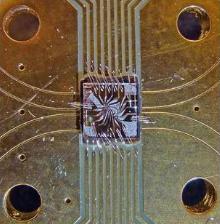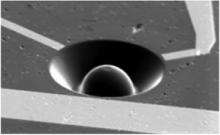
Quantum Control Protocols Could Lead to More Accurate, Larger Scale Quantum Computations


A protocol for controlling quantum information pioneered by researchers at UC Santa Barbara, the Kavli Institute of Nanoscience in Delft, the Netherlands, and the Ames Laboratory at Iowa State University could open the door to larger-scale, more accurate quantum computations. Their findings, in a paper titled "Decoherence-protected quantum gates for a hybrid solid-state spin register," are published in the current issue of the journal Nature.
"Although interactions between a quantum bit (‘qubit') and its environment tend to corrupt the information it stores, it is possible to dynamically control qubits in a way that facilitates the execution of quantum information-processing algorithms while simultaneously protecting the qubits from environment-induced errors," said UCSB physicist David Awschalom. He and his group were responsible for developing the electron and nuclear spins used as the quantum bits –– the quantum version of the computer bit –– in their demonstration and for helping to analyze the results.
Awschalom is director of UCSB's Center for Spintronics & Quantum Computation, professor of physics, electrical and computer engineering, and the Peter J. Clarke Director of the California NanoSystems Institute.
Dynamical protection of quantum information is essential for quantum computing as the qubits used for information processing and storage are highly susceptible to errors induced by interactions with atoms in the qubits' environment. The scientists' previous research has shown that quantum information stored in qubits can be effectively protected through successive control operations (rotations) on a qubit that filter out these unwanted interactions. However, these control operations also filter out the interactions between qubits that are essential for the realization of logic gates for quantum information processing. Thus, until recently, quantum information stored in protected qubit states could not be used for quantum computations.
The research team, which also included members from the University of Southern California, showed that by precisely synchronizing the rotations of an electron spin with the rotation of a nearby nuclear spin, they could realize dynamical protection of both qubits from the environment while maintaining the interactions between the two spins that are necessary for quantum information processing. As a proof of principle, the researchers demonstrated the high-fidelity execution of a quantum search algorithm using this two-qubit system. Quantum search algorithms, if executed on a larger number of qubits, could provide search results of certain databases considerably faster than search algorithms performed on a classical computer.
The results of this study point to greater possibilities for quantum computers that overcome, according to Awschalom, the perception that spin qubits in semiconductors, such as those used in this work, suffer from too strong of environmental interactions to be useful qubits. These solid state spin systems also offer the added benefit of operating at room temperature, in contrast to other candidate qubit systems which operate at only at a fraction of a degree above absolute zero.
"This demonstration of performing a quantum algorithm at the subatomic level with single spins suggests a pathway to build increasingly complex quantum machines, using qubit control protocols that circumvent the expected limitations from real materials," said Awschalom.
† Middle photo: The quantum circuit used in the demonstration is a 3mm x 3mm chip with a 1mm x 1mm diamond in the middle. Credit: Delft University of Technology/UC Santa
Barbara.
†† Bottom photo: A 20 micron x 20 micron magnification of the diamond chip, showing an integrated diamond lens above the single particle spins where the calculations take place.
Related Links
The Awschalom Group
The Ames Laboratory
The Kavli Institute for Nanoscience



